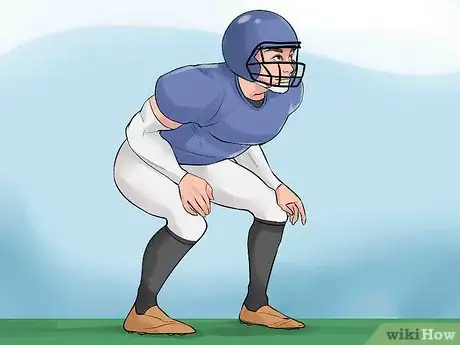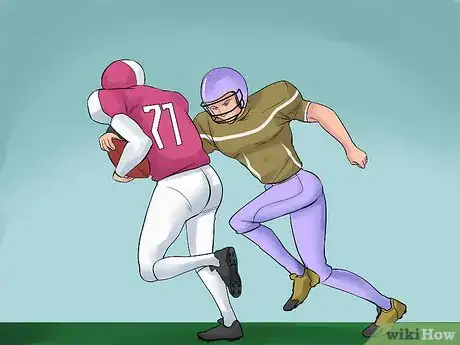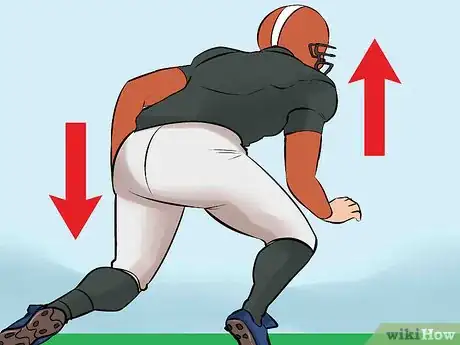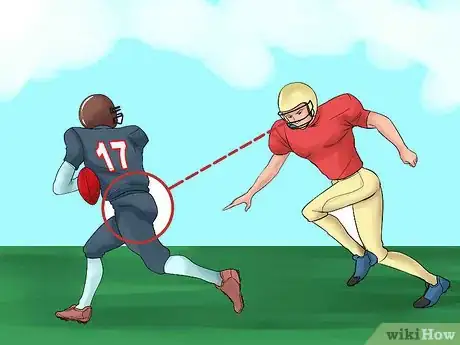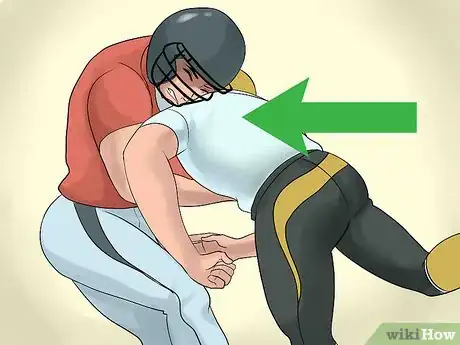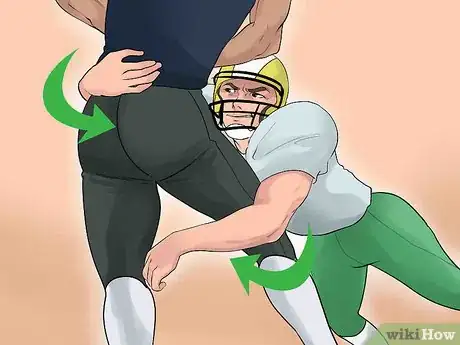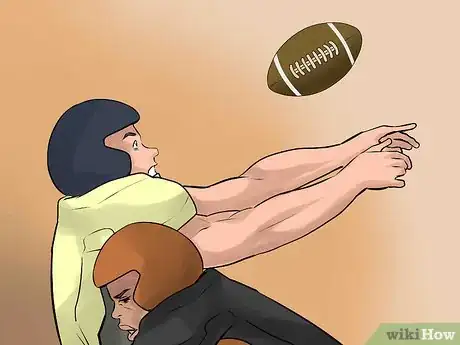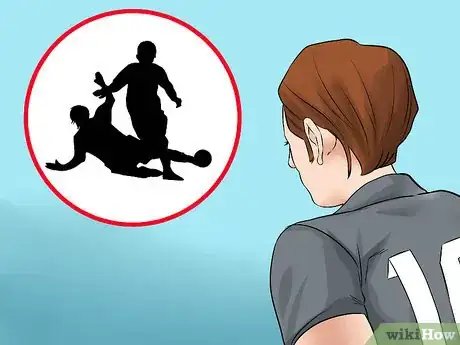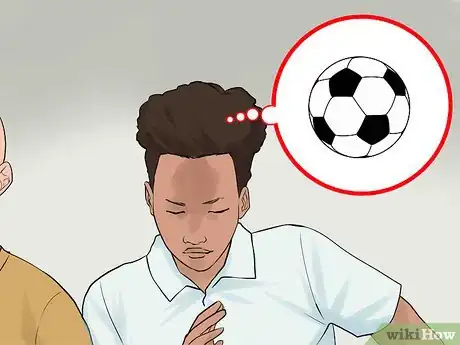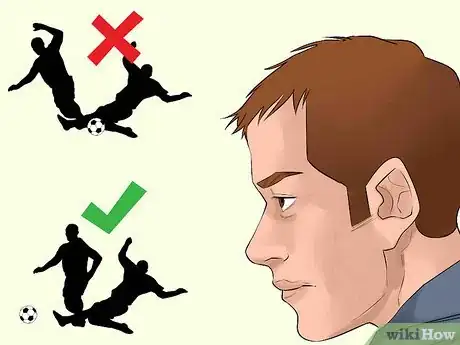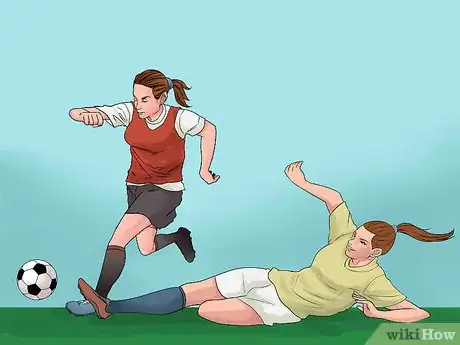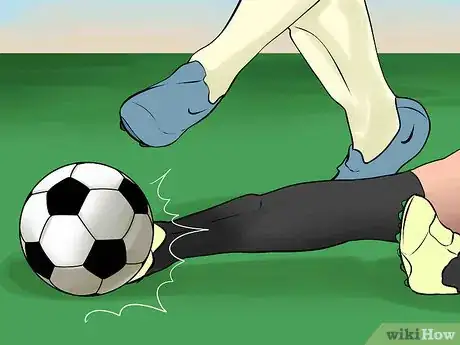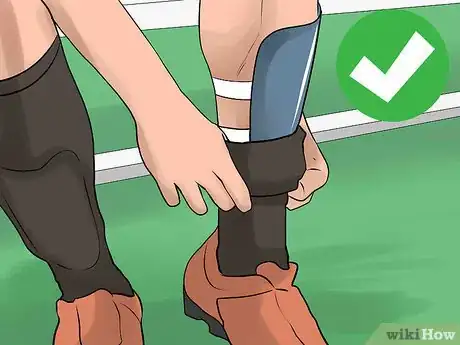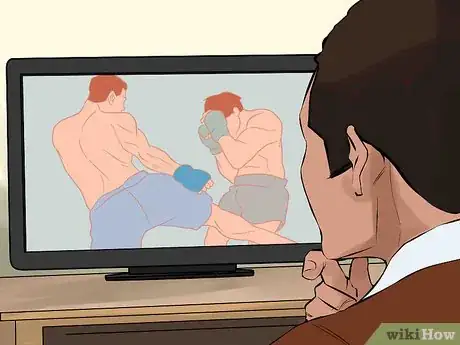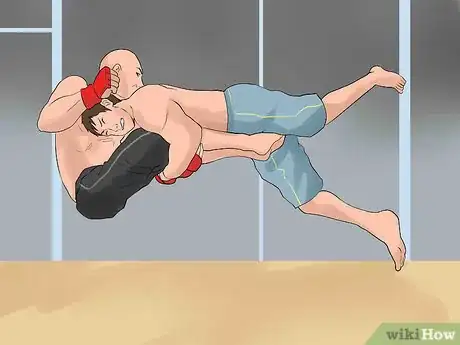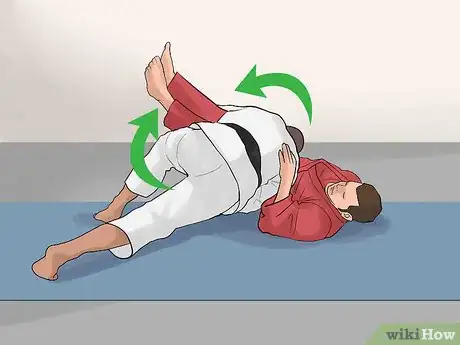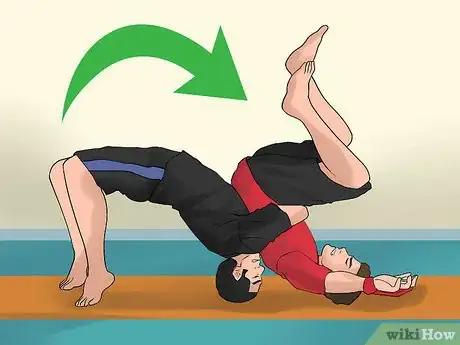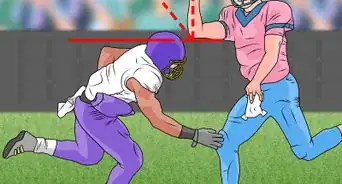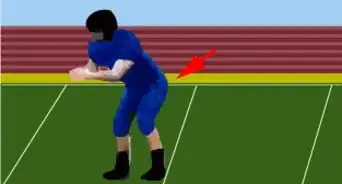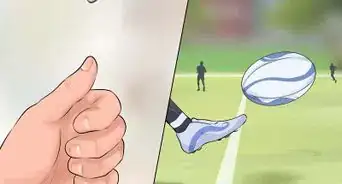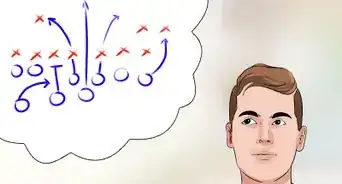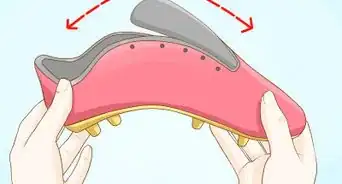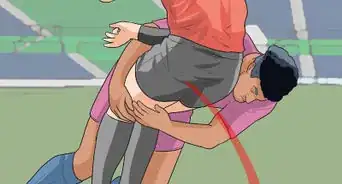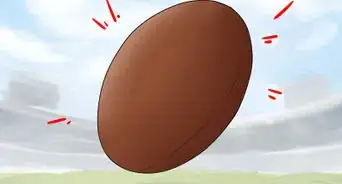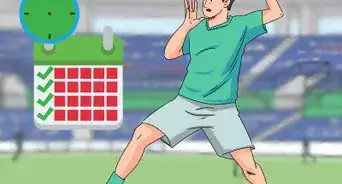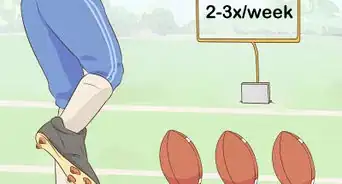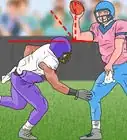wikiHow is a “wiki,” similar to Wikipedia, which means that many of our articles are co-written by multiple authors. To create this article, 36 people, some anonymous, worked to edit and improve it over time.
This article has been viewed 111,759 times.
Learn more...
Consistent, effective tackling is one of the most important facets of a strong defense in American football, soccer, and in mixed martial arts. In any sport, good tackling requires proper technique and training to execute correctly. Even a smaller athlete with the right form can tackle an opponent much larger or stronger. This article will break down how to tackle safely, properly, and effectively in three sports. See Step 1 for more information.
Steps
Tackling in American Football
-
1Maintain the proper position and tackling form. Your head should be up and your eyes should be on the ball carrier at all times when you're playing defense. Your feet should be shoulder-width apart, with your knees bent and your shoulders back. Ideally, you want to have your back at about 45 degrees relative the ground.
- This is sometimes referred to as "breakdown" position. While you're working out, practicing hopping into breakdown and "buzzing" your feet, switching your weight between them very quickly, like you're standing on hot coals and you want to get them off. Stay light and mobile, and you'll be in good form.
-
2Close the distance between yourself and the ball carrier. Accelerate toward the ball-carrier as quickly as possible, then slow down when you get without about three yards of the offensive player. If you keep moving at breakneck speed, you'll be out of position and the player will blow right past you. When you get close, slow down and drop into breakdown, relying upon your lateral movements to make the tackle.
- It'll take some practice to determine the proper angle of pursuit. This depends on the distance between you and the ball carrier and the speed of the ball carrier. If the ball carrier is particularly fast, take a wide angle of pursuit that will allow you to stay between him and your end zone.
Advertisement -
3Go into breakdown position and buzz your feet. Bend your knees, get your hips down, and keep your hands back. Maintain an even center of gravity by keeping your feet at least shoulder width apart. Don't flat-foot it, either, keep moving and watch the offensive player's movements.
- Always keep your head up and your back straight. This position is more balanced and safer. Under no circumstances should you ever lead with your head down, which is extremely dangerous for both you and the ball carrier.
-
4Watch the hips. Ideally, you want your head to be across the ball carrier's body and in his path. If the ball carrier is going to your left, when you make the tackle he should be on the right side of your head. The opposite is true if he's running to your right. Watch the player's hips closely to tip you off on changes in direction as you close and as you make contact. Proper tackling placement will take the opponent off balance, making him less likely to fall forward for an extra yard or so, which can make all the difference on third down.
-
5Make contact. When the ball carrier is within your reach, push off with your feet as hard as you can and use your legs to drive through your opponent. Drive your lead shoulder into the ball carrier's hips. Keep pushing and driving with your feet until the ball carrier goes down. Pick your knees up high in the driving motion, following through the tackle.
-
6Wrap up. As your shoulder pads connect with the ball carrier, wrap him up with your arms just under his butt. This allows you to not only knock him over, but pull to his legs out from under him when you extend through him, resulting in a lower chance of your tackle being broken. It also results in some spectacular, highlight-worthy "hits" where you really don't have to hit very hard, just with good technique. Don't stop driving until the ball carrier is down and the whistle is blown.
-
7Don't worry about stripping the ball. Good tackles happen because of proper form and hit-placement. Although the NFL highlight reels are filled with spectacular-looking flying tackles and hits that jostle the ball loose, focusing on making that happen every time will make you miss tackles, pure and simple. Stay focused on getting the ball player on the ground, not stripping the ball.
- If you're assisting a tackle, go for the ball, trying to get a hand on it and rip in a down-and-out motion. If your teammate clearly has the tackle in hand, you can do some good by going for the ball at that point, but not before.
- Never leave your feet to make a tackle, and never lead with your head. This is an illegal maneuver and extremely dangerous.
Tackling in Soccer
-
1Only go to the ground as a last-ditch defense. Slide tackles should be a relatively rare element of your game. A defender should only go to the ground if there is no possibility of defending the play while standing up. If the offensive player is going around you and you have no support, it might be appropriate to go to the ground to stop an offensive charge and give your support a chance to catch up. A good slide tackle usually takes the ball out of bounds, changes possession, or otherwise clears it.
- Making an unsafe slide tackle warrants an automatic red card and ejection from the came, with the possibility of further punishments from the league or your coaches. Only use the maneuver if absolutely necessary.
-
2Run parallel to the player in possession. The best time for a slide tackle is when you and your opponent are running parallel, toward the ball, and that you're going to lose possession very quickly if you don't make a move now. If you can't get a foot on the ball while you're in a standing position, and you're about to lose ground, it's the perfect time for a tackle.
- Never make a slide tackle from behind. Tackles from behind or from head-on are very dangerous and the possibility of a penalty is high. It's possible to do it correctly in some situations, like if you're both going for the ball but neither is in possession, but not recommended unless you're sure you'll be able to get to the ball first.
-
3Watch the ball closely and wait until you see separation. The ideal moment for a slide tackle is just after the player in possession has kicked the ball, creating separation between that player's body and the ball itself. That will give you the most room to maneuver and get your foot in the way. Keep your eye on the ball and watch absolutely nothing but the ball while you slide through to tackle. A good slide tackle should be focused on nothing but getting the ball out of the way.[1]
-
4Check your emotions at the door. Before you decide to take it to the ground, do a quick double check of your emotions. You don't slide tackle a player, you slide tackle the ball to get your team control. Targeting a player will get you ejected and possibly kicked off the team.
-
5Slide into the tackle, don't jump into the tackle. Lead with your dominant foot–the foot you use to kick with–and hook your leg into the ball, making contact with ball first and foremost, and sliding as softly as possible onto the ground, through the ball, and across your opponent's path.
- A proper slide tackle is just like a baseball slide. You shouldn't leap up into the air and come crashing down on your hip, or you risk hurting yourself. Drop the shoulder closest to the ball and slide with your leg extended.
- Never slow down before taking it to the ground. You should accelerate into a slide to make sure that your leg follows through with the motion, clearing the ball, not just falling flat.
-
6Make sure you get the ball. The legality of the slide tackle depends totally on whether or not you contact the ball first. If you clear the ball, then your opponent trips over your and lands face-first on the ground, it's legal. If you clip your opponent's shin and then clear the ball, you're going to get at least a yellow card warning, and probably worse.
-
7Protect yourself. Never slide tackle unless you're wearing form-fitting shin guards of the proper size. You're throwing your leg out there to be tripped over, potentially, or stepped on by a pair of cleats, making it essential that you guard yourself. Shin guards might not be the most comfortable things to play in, but if you're going to be taking it to the ground, they're absolutely essential.
Tackling in Mixed-Martial Arts
-
1Learn when tackles and takedowns are appropriate in a fight. In mixed martial arts, "tackles" are generally called "takedowns," and are used to–you guessed it–take your opponent to the mat and fight on the ground. It's appropriate especially when you're fighting someone who is primarily strike-oriented, and you're more of a mat-wrestler, or think you have a better chance winning with your ground game.
-
2Use the double-leg takedown against heavy strikers. The most common takedown in MMA is the double-leg takedown, in which you drive your shoulders into your opponent's hips, grabbing both legs behind the knees and pulling them in close to you. Many fighters will drive the opponent up into the air slightly after being taken off their feet, to make the impact on the ground more powerful. For added bonus points, cage fighters can drive their opponents into the cage first, using it as an ally.
- Wait for a flurry of punches to shoot down and take out the legs. Georges St. Pierre is particularly good at waiting until the opponent has dropped guard to strike and opened up to the double-leg.
- Freestyle wrestlers will also commonly use this move, but often somewhat lower than the MMA fighter. Technique-wise, a freestyle wrestler will often drop to their knees very quickly, shooting into the opponent's shins to pull them backward off their feet, whereas the MMA fighter needs to defend from strikes, which makes it more necessary to stay upright.
- In Judo, the double-leg takedown is called the morote-gare, and has been a legal maneuver since the early 80s.
-
3Use the body lock takedown if you miss a punch. Find yourself having thrown an overhand haymaker and missed wildly? The good news is you've probably worked your way in close enough that you can grab on for a body lock. In a body lock, you'll basically wrap your opponent's waist in your arms, with your head next to their head. To take it to the mat, wrap your dominant striking leg behind your opponent's and rotate your shoulders to turn and bring him off his feet, into the mat.
- Be prepared to get a knee to the gut, or defend elbows. This isn't the most defensive-minded position, but if you execute it quickly enough, it can be a good way to get yourself out of a sticky situation, and cause a lot of damage.
-
4Use the half-guard tackle pass. If your opponent is on his back in half-guard, the tackle pass is an excellent way of breaking it and getting back in control of the fight. To execute the maneuver, you basically want to roll your opponent over using the weight of your shoulders on his hips, using enough pressure to get one arm under his hip and butt area. Shoot that hand underneath and wrap up with your other hand, applying pressure and rolling him onto his back.
-
5Go for a suplex. They're not just for pro wrestling anymore. From a clinch or a double-overhook, a suplex can be an excellent and surprisingly legal way of taking your opponent to the mat. In the suplex, you'll wrap your opponent's torso, from either the front or the back, then twist them in the air and slam them to the mat. Easier said than done, and much more amenable to a weaker or smaller opponent, it's a common part of some MMA fighters offense, like Jon "Bones" Jones.[2]
- Practice this in this gym before trying it. A lot. Done incorrectly, your opponent with land on your instead, and you'll end up with an angry dude sitting on your chest ready to pound your lights out.
Warnings
- Never drop your head! Always keep it up! If you drop your head, you put yourself at risk for becoming paralyzed. You can also injure the opposing player and draw penalties.⧼thumbs_response⧽
References
About This Article
To tackle in American football, move toward the ball carrier as quickly as possible, only slowing down when you get within 3 yards of them. Then, place your feet a shoulder-width apart and bend your knees, keeping your head up and back straight. Once you know which direction the player is going to go, push off with your feet as hard as you can and use your legs and shoulder to drive through your opponent at hip level. As your shoulder pads connect with the ball carrier, wrap your arms around them, just under their butt. Keep pushing and driving with your feet until the ball carrier goes down! To learn about tackling in other sports, like soccer, read on!
